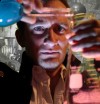[editor’s note: This originally appeared on Tracy Hyorth’s blog. Her husband Alphie is in one of the shows]
All of Asheville’s theatrical community is finally playing together. And it’s about damn time. Actors who did cutting edge shows in the ‘80s, to newer players who have happily learned good theatre does happen in this town. There’s even one actor who worked with the earlier group, and has kept chugging on along the entire time. When Jekyll Met Hyde, opening Thursday, Jan. 20 at The Magnetic Field, is where the magic takes place. The show is also a world premiere of a script written 23 year ago by Magnetic Theatre Artistic Director Steven Samuels.
Asheville has been waiting for like 20 years for its River District to pop wide open. And that’s just about to happen. It’s already alive with artists with crazier-than-cool studios, funky cafes, and now a theatre/café/bar, featuring only all-original performance pieces. The Magnetic Field, down on Depot Street, is creating all sorts of buzz. If you don’t know that the nightspot was recently featured in a New York Times travel piece, you have not been reading much media lately. And you’re certainly not a local theatre freak. Time for you to change that status.
When Jekyll Met Hyde draws on every written, dramatized, and filmed version of the Robert Louis Stevenson classic imaginable, relevant 19th-century literary and philosophical classics and features, and an unusual feminist twist and a surprise ending, Samuels explains before a recent tech rehearsal on location.
Samuels was in the right place at the right time and worked at The Ridiculous Theatrical Company in New York City from the late ‘70s to the early ‘90s. That group, begun in the mid ‘60s, is credited with breaking “the dominant trends in theatre of naturalistic acting and realistic settings. It employed a very broad acting style, often with surrealistic stage settings and props, frequently making a conscious effort at being shocking or disturbing,” according to Wikipedia. (I can’t believe I just quoted Wikipedia, btw, but it has become a part of our sourcing culture. Besides, Samuels would say that description is essentially correct.)
Samuels points out that he worked with Charles Ludlam in various theatrical ways, both on stage and off. Ludlam was a renowned American actor, director and playwright who either taught or staged productions at New York University, Connecticut College for Women, Yale University and Carnegie Mellon University. He won fellowships from the Guggenheim, Rockefeller and Ford Foundations and grants from the National Endowment for the Arts and the New York State Council on the Arts. He won four Obie Awards. He was also instrumental in making the ‘Ridiculous’ theatrical experience a major influence still seen on American stages today.
Samuels decided to put together When Jekyll Met Hyde in 1988, 10 months after Ludlam died, having been diagnosed with AIDS.
“Ludlam was this wonderful cultural recycler. He didn’t believe he had the right to add any new words to the theatrical arena because so much great stuff had already been created. So, he would create these collages of plots … outrageously put together quotes from all these different sources to tell the story of a classic.”
That’s what Samuels did with When Jekyll Met Hyde. For a month, he dived into the original Stevenson classic and learned as much as he could about it. Then he created his own collages from works like Dracula or Frankenstein, to name just a few. But there’s also a lot of Samuels’ own words in this play. He saw that even more as he prepared it for the Magnetic performance:
“There’s about as much real Samuels in the dialogue as there is real fruit in Hawaiian Punch: 10 percent. What I’ve realized subsequently is that it’s probably more like 15 percent, maybe 20 percent if you count my translations of Baudelaire as ‘Samuels.’”
And to add just another twist, in homage to Ludlam and the character of the original work, Samuels has written two versions. There’s a ‘50s and a ‘60s version. Both shows have different actors, with the exception of one actor who is in both versions.
Why choose two decades so close together?
“The ‘50s and ‘60s seem and are very close, but they have very distinctive, tremendous extremes,” Samuels said. This difference is reflected through the costumes, music and the actors.
“It’s totally insane,” Samuels said in parting. “Wonderfully. Totally. Insane.”
The Magnetic Field will show both versions simultaneously. Featured in the 1950s version, Mondy Carter, Tracey Johnston-Crum, John Crutchfield, Darren Marshall and Alphie Hyorth; in the 1960s version, John Crutchfield, Kathryn Temple, Julian Vorus, Steph Anie and Peter Brezny. For more information, http://www.themagneticfield.com/when-jekyll-met-hyde




One note of clarification: the script is the same for both versions of the play. It’s the interpretation that differs. As the one actor who appears in both versions, I can attest to the fact that the differences are pretty wild.
Is this a review or a plug for the Magnetic Field appearing on the Sightlines page? Can anyone plug their work on this page now? I hope so as that would actually be useful.
I had the same question, skiplunch. While a thoughtful and interesting piece, it seemed to me to belong elsewhere in the paper, not in the review section. And while I’m not sure I agree that Sightlines should expend to include previews as well as reviews, I do think that such articles are of as much –and possibly greater– value. But the question remains: was this preview in the review section a fluke, or a harbinger?